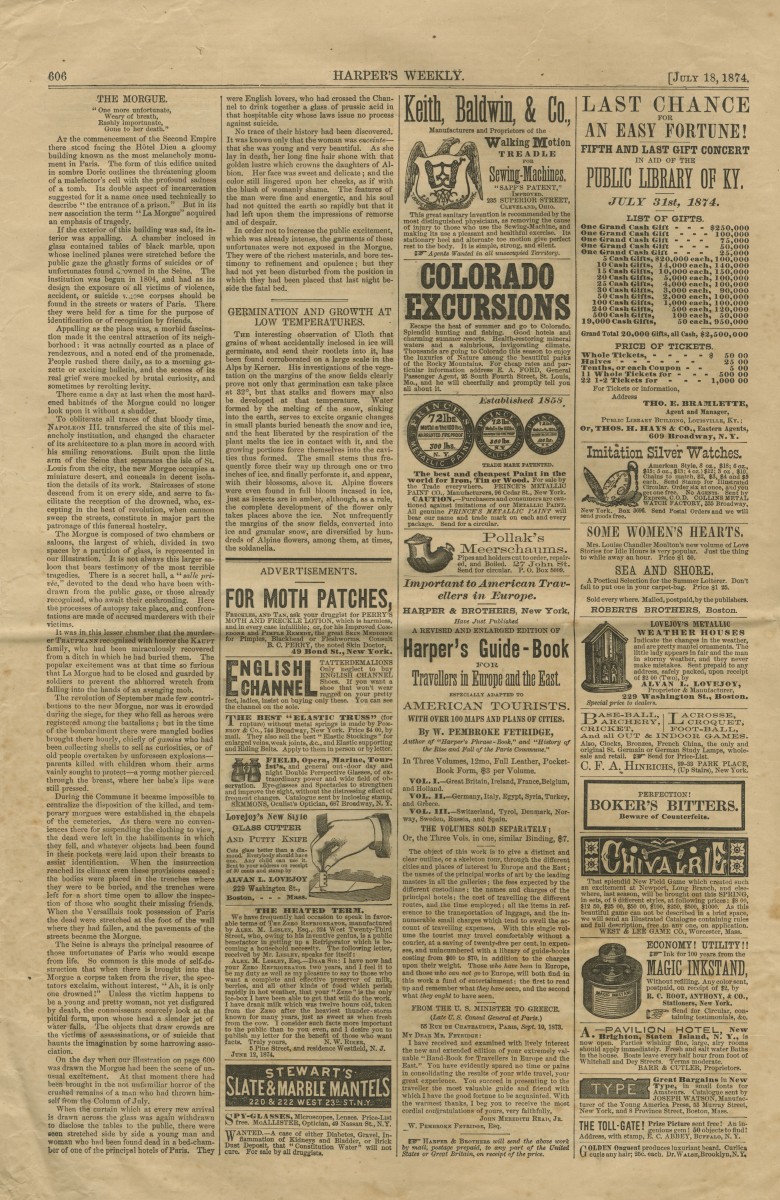-
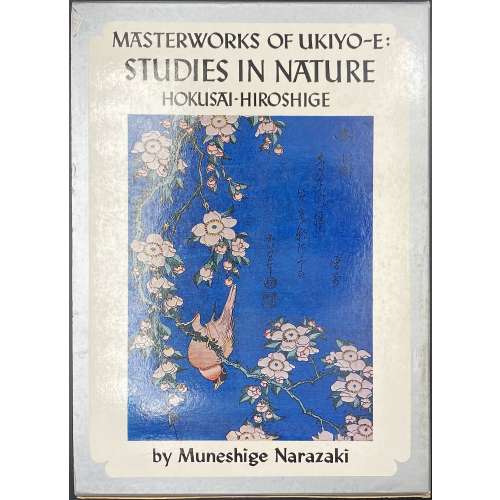 Hardcover volume from the series Masterworks of ukiyo-e, 26.3 x 19.2 cm, bound in unprimed canvas, red characters on black strip to front, red and black lettering to spine, tan flat endpapers, in a pictorial slipcase with series design (black lettering on silver spine); pp: [1-6]: h.t./frontis. (colour plate pasted in), t.p./imprint, contents/acknowledgements), 7-31 text, [32] blank, 33-96 (58 plates w/captions). Title-page (in frame): MASTERWORKS OF UKIYO-E | STUDIES IN NATURE | HOKUSAI-HIROSHIGE | by Muneshige Narazaki | Translated by John Bester | {publisher’s device} | KODANSHA INTERNATIONAL LTD. | Tokyo, Japan & Palo-Alto, Calif., U.S.A | {vertical, between rules 花鳥風月} || 花鳥風月 (Kachou Fugetsu) – beauties of nature. Series: Masterworks of ukiyo-e, № 11. Contributors: Muneshige Narazaki [楢崎 宗重] (Japanese, 1904 – 2001) – author. John Bester (British, 1927 – 2010) – translator. Katsushika Hokusai [葛飾 北斎] (Japanese, 1760 – 1849) – artist. Utagawa Hiroshige [歌川 広重] a.k.a. Andō Hiroshige [安藤 広重] (Japanese, 1797 – 1858) – artist.
Hardcover volume from the series Masterworks of ukiyo-e, 26.3 x 19.2 cm, bound in unprimed canvas, red characters on black strip to front, red and black lettering to spine, tan flat endpapers, in a pictorial slipcase with series design (black lettering on silver spine); pp: [1-6]: h.t./frontis. (colour plate pasted in), t.p./imprint, contents/acknowledgements), 7-31 text, [32] blank, 33-96 (58 plates w/captions). Title-page (in frame): MASTERWORKS OF UKIYO-E | STUDIES IN NATURE | HOKUSAI-HIROSHIGE | by Muneshige Narazaki | Translated by John Bester | {publisher’s device} | KODANSHA INTERNATIONAL LTD. | Tokyo, Japan & Palo-Alto, Calif., U.S.A | {vertical, between rules 花鳥風月} || 花鳥風月 (Kachou Fugetsu) – beauties of nature. Series: Masterworks of ukiyo-e, № 11. Contributors: Muneshige Narazaki [楢崎 宗重] (Japanese, 1904 – 2001) – author. John Bester (British, 1927 – 2010) – translator. Katsushika Hokusai [葛飾 北斎] (Japanese, 1760 – 1849) – artist. Utagawa Hiroshige [歌川 広重] a.k.a. Andō Hiroshige [安藤 広重] (Japanese, 1797 – 1858) – artist. -
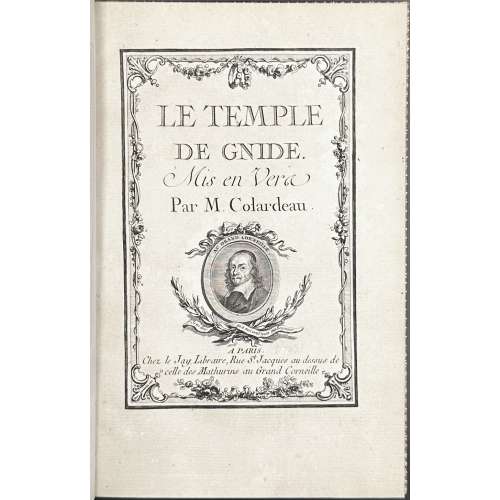 Hardcover volume, 8vo, 21.5 x 14.5 cm, bound by Riviere & Son (stamped on fep verso bottom) in full brown calf, boards with triple gilt fillet border and gilt dentelle inside, spine with raised bands, gilt in compartments, black label with gilt lettering, all margins gilt, blue endpapers, bookplate of Arthur Rau pasted to front pastedown (text: Les hommes sont méchants mais leurs livres sont bons / Arthur Rau; signed: E. H. New – A.D. 1922), traces of removed owner’s label to fep recto; printed on laid paper. Title-page (engraved, in floral frame): LE TEMPLE | DE GNIDE. | Mis en Vers | Par M. Colardeau | {vignette with portrait of Pierre Corneille} | A PARIS | Chez le Jay, Libraire, Rue St. Jacques au dessus de | celle des Mathurins au Grand Corneille || Collation: 2 blanks, h.t., engraved t.p. with a portrait of Pierre Corneille, a8, A-E8 F4 (52 leaves), 2 blanks, plus 7 plates by various engravers after Charles Monnet. Pagination: [i] ii-xvi, [1] 2-88 (104 pp). Ref: MFA (Boston): accession number 37.1747 Catalogue raisonné: Lewine 114, Cohen-DeRicci 245-6. Contributors: Charles Monnet (French, 1732 – after 1808) – artist. Engravers: Jean Charles Baquoy (French, 1721 – 1777) Nicolas Delaunay (French, 1739 – 1792) Isidore Stanislas Helman (French, 1743 – 1806) Louis Joseph Masquelier (French, 1741 – 1811) François Denis Née (French, 1735 – 1818) Nicholas Ponce (French, 1746 – 1831) Portrait(s) designed by: Guillaume Voiriot (French, 1713 – 1799) Author: Charles-Pierre Colardeau (French, 1732 – 1776) Publisher: Edmé-Jean Le Jay (French, 1734 – 1795) Bookplate artist: Edmund Hort New (British, 1871 – 1931) Provenance: Arthur Rau (British, 1898 – 1972); his obituary can be found in The Book Collector 1973, vol. 22, n°1, p. 86-89. According to the genealogy service Geni, Arthur Aron Rau was born to Jacob Aryeh Rau and Katharina (Kaethe) Rau, and has a sister Cecilia (Tsipporah) Rosenfelder and a brother Frederick Solomon Rau. He went to Oxford and then joined Maggs Brothers in their Paris establishment. "After some years there, he set up on his own, returning to England at the outbreak of the Second World War to be a schoolmaster for ten years". In 1949 he returned to Paris and retired in 1963, "and his last years he happily spent in Wensleydale...". All he published during his lifetime were two catalogues, Livres Rares Et Anciens. Manuscrits et Autographes. — Paris: Arthur Rau, 1932-3 and Cinquante Tres Beaux Livres Avec Un Appendice. — Paris: Arthur Rau, 1933. He also contributed to The Book Collector.Seller’s description: In-8° : [2]-t. gr.-xvi-88 pp. ; 7 h.-t. (qqs rouss.). - Poème d'après le roman de Montesquieu ill. de 7 eaux-fortes par Bacquoy, Delaunay, Née, etc., d'après Charles Monnet. Titre gr. orné d'un portr. de Corneille. Cohen, qui cite un ex. millésimé 1773, signale des ex. avec la date de 1772 ou sans date. - Réf. Cohen 245-246. - Conlon 72:675 (éd. à l'adresse d'Amsterdam et Paris, 1772). - Pas dans Reynaud. - Prov. Arthur Rau (1898-1972), gérant de la librairie Maggs à Paris avant d'ouvrir sa propre librairie en 1932 (ex-libris gr. par E.H. New, 1922 ; réf. BnF). - Traces d'ex-libris décollé à la garde sup.
Hardcover volume, 8vo, 21.5 x 14.5 cm, bound by Riviere & Son (stamped on fep verso bottom) in full brown calf, boards with triple gilt fillet border and gilt dentelle inside, spine with raised bands, gilt in compartments, black label with gilt lettering, all margins gilt, blue endpapers, bookplate of Arthur Rau pasted to front pastedown (text: Les hommes sont méchants mais leurs livres sont bons / Arthur Rau; signed: E. H. New – A.D. 1922), traces of removed owner’s label to fep recto; printed on laid paper. Title-page (engraved, in floral frame): LE TEMPLE | DE GNIDE. | Mis en Vers | Par M. Colardeau | {vignette with portrait of Pierre Corneille} | A PARIS | Chez le Jay, Libraire, Rue St. Jacques au dessus de | celle des Mathurins au Grand Corneille || Collation: 2 blanks, h.t., engraved t.p. with a portrait of Pierre Corneille, a8, A-E8 F4 (52 leaves), 2 blanks, plus 7 plates by various engravers after Charles Monnet. Pagination: [i] ii-xvi, [1] 2-88 (104 pp). Ref: MFA (Boston): accession number 37.1747 Catalogue raisonné: Lewine 114, Cohen-DeRicci 245-6. Contributors: Charles Monnet (French, 1732 – after 1808) – artist. Engravers: Jean Charles Baquoy (French, 1721 – 1777) Nicolas Delaunay (French, 1739 – 1792) Isidore Stanislas Helman (French, 1743 – 1806) Louis Joseph Masquelier (French, 1741 – 1811) François Denis Née (French, 1735 – 1818) Nicholas Ponce (French, 1746 – 1831) Portrait(s) designed by: Guillaume Voiriot (French, 1713 – 1799) Author: Charles-Pierre Colardeau (French, 1732 – 1776) Publisher: Edmé-Jean Le Jay (French, 1734 – 1795) Bookplate artist: Edmund Hort New (British, 1871 – 1931) Provenance: Arthur Rau (British, 1898 – 1972); his obituary can be found in The Book Collector 1973, vol. 22, n°1, p. 86-89. According to the genealogy service Geni, Arthur Aron Rau was born to Jacob Aryeh Rau and Katharina (Kaethe) Rau, and has a sister Cecilia (Tsipporah) Rosenfelder and a brother Frederick Solomon Rau. He went to Oxford and then joined Maggs Brothers in their Paris establishment. "After some years there, he set up on his own, returning to England at the outbreak of the Second World War to be a schoolmaster for ten years". In 1949 he returned to Paris and retired in 1963, "and his last years he happily spent in Wensleydale...". All he published during his lifetime were two catalogues, Livres Rares Et Anciens. Manuscrits et Autographes. — Paris: Arthur Rau, 1932-3 and Cinquante Tres Beaux Livres Avec Un Appendice. — Paris: Arthur Rau, 1933. He also contributed to The Book Collector.Seller’s description: In-8° : [2]-t. gr.-xvi-88 pp. ; 7 h.-t. (qqs rouss.). - Poème d'après le roman de Montesquieu ill. de 7 eaux-fortes par Bacquoy, Delaunay, Née, etc., d'après Charles Monnet. Titre gr. orné d'un portr. de Corneille. Cohen, qui cite un ex. millésimé 1773, signale des ex. avec la date de 1772 ou sans date. - Réf. Cohen 245-246. - Conlon 72:675 (éd. à l'adresse d'Amsterdam et Paris, 1772). - Pas dans Reynaud. - Prov. Arthur Rau (1898-1972), gérant de la librairie Maggs à Paris avant d'ouvrir sa propre librairie en 1932 (ex-libris gr. par E.H. New, 1922 ; réf. BnF). - Traces d'ex-libris décollé à la garde sup. -
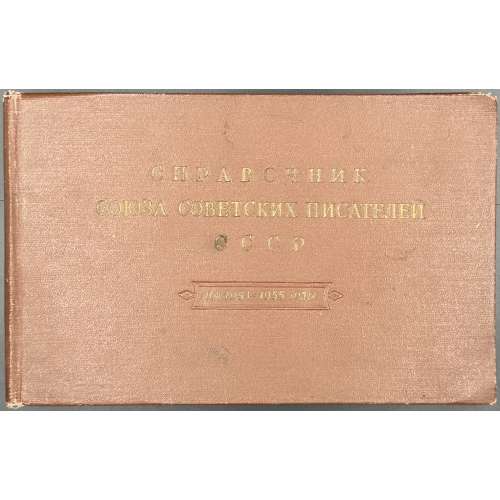 Oblong hardcover volume, 13.3 x 21 cm, bound in brown buckram with embossed gilt lettering to front, pp.: [1-4] 5-482 [2] errata leaf tipped-in. Title-page: СОЮЗ СОВЕТСКИХ ПИСАТЕЛЕЙ СССР | СПРАВОЧНИК | на 1954 — 1955 годы | ИЗДАТЕЛЬСТВО «Советский писатель» | МОСКВА 1954 || On page 71, second from bottom: Варшавский Сергей Петрович, г. Ленинград, Ропшинская ул., д. 1/32, кв. 18, тел. В 3-56-00. Print run: 3,000 copies.
Oblong hardcover volume, 13.3 x 21 cm, bound in brown buckram with embossed gilt lettering to front, pp.: [1-4] 5-482 [2] errata leaf tipped-in. Title-page: СОЮЗ СОВЕТСКИХ ПИСАТЕЛЕЙ СССР | СПРАВОЧНИК | на 1954 — 1955 годы | ИЗДАТЕЛЬСТВО «Советский писатель» | МОСКВА 1954 || On page 71, second from bottom: Варшавский Сергей Петрович, г. Ленинград, Ропшинская ул., д. 1/32, кв. 18, тел. В 3-56-00. Print run: 3,000 copies. -
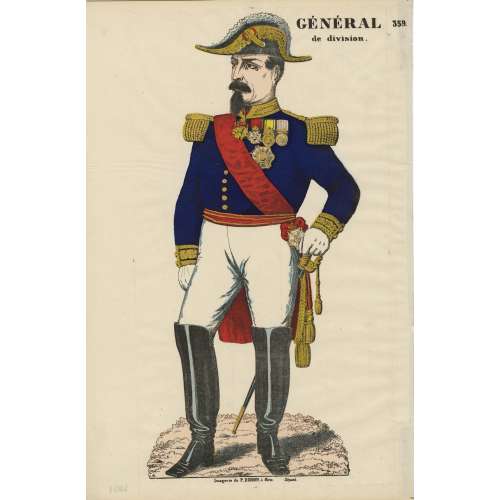 Hand-coloured woodcut on wove paper, 430 x 285 mm; black ink stamp “5051” to reverse. Top right: "GÉNÉRAL | de division." — "359." Bottom: "Imagerie de DIDION, à Metz. Déposé." Paulin Didion (French, 1831 – 1879) – publisher/printer.
Hand-coloured woodcut on wove paper, 430 x 285 mm; black ink stamp “5051” to reverse. Top right: "GÉNÉRAL | de division." — "359." Bottom: "Imagerie de DIDION, à Metz. Déposé." Paulin Didion (French, 1831 – 1879) – publisher/printer. -
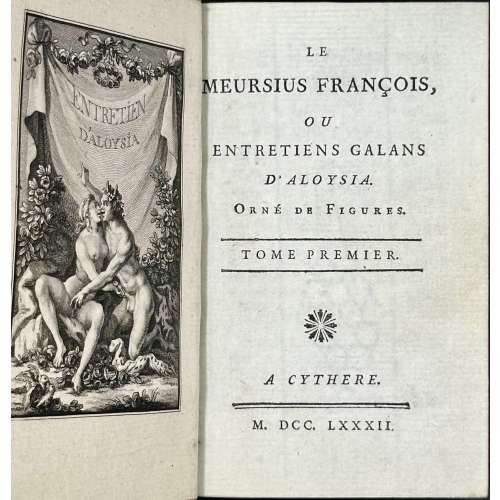 Hardcover volume, 12mo, 125 x 85 mm, two parts in one, bound and gilded by Cuzin and Maillard, respectively, between 1876 and 1881, in crimson crushed morocco with raised bands and gilt lettering to spine, marbled endpapers, all edges gilt, gilt dentelle, signed 'Cuzin' to foot of front turn-in and 'Maillard dor.' to rear. Adorned with engraved frontispiece and 12 plates by Elluin after Borel. Text printed on a slightly bluish paper. Title-page: LE | MEURSIUS FRANÇOIS, | OU | ENTRETIENS GALANS | D'ALOYSIA. | ORNÉ | DE FIGURES. | — | TOME PREMIER (SECOND) | — | ✵ | A CYTHERE | — | M. DCC. LXXXII. || Collation: 12mo, π4 (2 blanks) A-Z6 χ1,+ π2 A-S6 (4 blanks) χ1, total 254 leaves; pagination: [8] [1] 2-277 [278 blank], [4] [1] 2-210 [8 blanks], total 508 pages, plus 13 engraved plates, incl. frontispiece. Catalogue raisonné: Cohen-de Ricci 240; Eros invaincu 17; Fekete 51; Nordmann (I) 91. Contributors: Nicolas Chorier (French, 1612 – 1692) – author. Antoine Borel (French, 1743 – 1810) – artist. François-Rolland Elluin (French, 1745 – c. 1822) – engraver. Hubert-Martin Cazin (French, 1724 – 1795) – publisher. Francisque Cuzin (French, 1836 – 1890) – bookbinder. Seller’s description: Erotica.- [Chorier (Nicolas)]Le Meursius François, ou Entretiens galans d'Aloysia, 2 parts in 1, half-title to each part, engraved frontispiece and 12 plates [by Elluin after Borel], handsomely bound in crimson crushed morocco by Cuzin, spine with gilt lettering and five raised bands, gilt tooled turn-ins by Maillard, signed 'Cuzin' to foot of front turn-in and 'Maillard dor.' to rear, marbled endpapers, g.e., fractional rubbing to extremities, an excellent copy, 12mo, Cythere [but Paris], [Cazin], 1782.
Hardcover volume, 12mo, 125 x 85 mm, two parts in one, bound and gilded by Cuzin and Maillard, respectively, between 1876 and 1881, in crimson crushed morocco with raised bands and gilt lettering to spine, marbled endpapers, all edges gilt, gilt dentelle, signed 'Cuzin' to foot of front turn-in and 'Maillard dor.' to rear. Adorned with engraved frontispiece and 12 plates by Elluin after Borel. Text printed on a slightly bluish paper. Title-page: LE | MEURSIUS FRANÇOIS, | OU | ENTRETIENS GALANS | D'ALOYSIA. | ORNÉ | DE FIGURES. | — | TOME PREMIER (SECOND) | — | ✵ | A CYTHERE | — | M. DCC. LXXXII. || Collation: 12mo, π4 (2 blanks) A-Z6 χ1,+ π2 A-S6 (4 blanks) χ1, total 254 leaves; pagination: [8] [1] 2-277 [278 blank], [4] [1] 2-210 [8 blanks], total 508 pages, plus 13 engraved plates, incl. frontispiece. Catalogue raisonné: Cohen-de Ricci 240; Eros invaincu 17; Fekete 51; Nordmann (I) 91. Contributors: Nicolas Chorier (French, 1612 – 1692) – author. Antoine Borel (French, 1743 – 1810) – artist. François-Rolland Elluin (French, 1745 – c. 1822) – engraver. Hubert-Martin Cazin (French, 1724 – 1795) – publisher. Francisque Cuzin (French, 1836 – 1890) – bookbinder. Seller’s description: Erotica.- [Chorier (Nicolas)]Le Meursius François, ou Entretiens galans d'Aloysia, 2 parts in 1, half-title to each part, engraved frontispiece and 12 plates [by Elluin after Borel], handsomely bound in crimson crushed morocco by Cuzin, spine with gilt lettering and five raised bands, gilt tooled turn-ins by Maillard, signed 'Cuzin' to foot of front turn-in and 'Maillard dor.' to rear, marbled endpapers, g.e., fractional rubbing to extremities, an excellent copy, 12mo, Cythere [but Paris], [Cazin], 1782. -
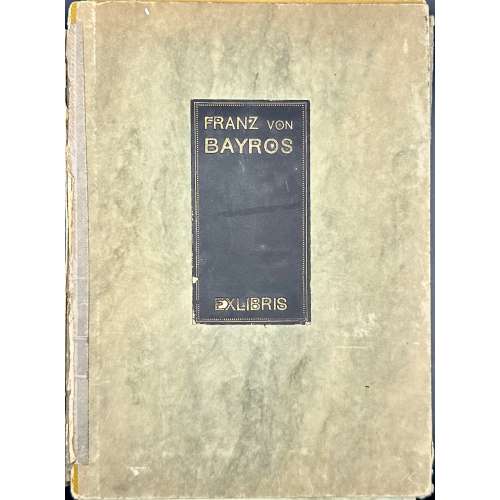 A set of 49 prints, heliogravures and etchings, tipped-in on 285 x 257 mm grey cards, in a green marbled folder with a gilt-lettered black label to the front. No publisher, no place, no year (s.l., s.n., s.d.), printed in circa 1910.
A set of 49 prints, heliogravures and etchings, tipped-in on 285 x 257 mm grey cards, in a green marbled folder with a gilt-lettered black label to the front. No publisher, no place, no year (s.l., s.n., s.d.), printed in circa 1910.- Vlastimil Blažek (Czech, 1878 – 1950): heliogravure, sheet 180 x 137 mm, plate 152 x 114 mm; laid paper, black sepia ink; unsigned.
- Ex libris Gerhard Wunderlich (architect in Dresden): heliogravure, sheet 205 x 150 mm, plate 158 x 115 mm; wove paper, brown sepia ink; inscription: heliogravure, sheet 180 x 137 mm, plate 152 x 114 mm; laid paper, sepia ink; inscription to top “Es ist alles so eng”; signed “F (backwards). Bayros”.
- Ex libris William Lipka: heliogravure, sheet 140 x 125 mm, plate 112 x 98 mm; laid paper, black sepia ink; signature hardly legible.
- Nikolaus Schindler (amateur photographer in Vienna): heliogravure, sheet 142 x 150 mm, plate 110 x 117 mm; laid paper, black sepia ink; unsigned.
- Sussy de Coiquard: heliogravure, sheet 160 x 140 mm, plate 128 x 110 mm; laid paper, black sepia ink; unsigned.
- Illegible, looks like “Vielluer Febréy”: heliogravure, sheet 120 x 109 mm, plate 93 x 85 mm; laid paper, black, sepia ink; signed “F (backwards). Bayros:”.
- Ex libris Erich Liebermann-Rosswiese (Greman-Jewish, 1886 – 1942): heliogravure, sheet 180 x 139 mm, plate 118 x 88 mm; wove paper, black sepia ink; unsigned.
- Ex libris Dr. phil. Rudolf Ludwig: before letters, heliogravure, sheet 150 x 132 mm, plate 120 x 110 mm; laid paper, black sepia ink; unsigned. See [LIB-3258.2023] John Cleland. Die Memoiren der Fanny Hill. — Paphos [i.e. Vienna]: C. W. Stern, 1906.
- Unidentified: before letters, heliogravure, sheet 150 x 115 mm, plate 113 x 88 mm; laid paper, black sepia ink; signed “F. Bayros” in the manuscript. Circumstantial evidence tells that this bookplate belongs to someone A.W.(Artur Wolf). See №22.
- Lulu. Monachia. Gest. v. Ritter Dialekt und Junker Erich: heliogravure, sheet 204 x 152 mm, plate 160 x 118 mm; wove paper, black sepia ink; unsigned. See №20.
- Kellner Jstván: (István): heliogravure, sheet 118 x 100 mm, plate 85 x 70 mm; laid paper, black sepia ink; signed “Franz Bayros” in the script (hardly legible).
- Adyton: heliogravure, sheet 170 x 130 mm, plate 113 x 85 mm; wove paper, black, sepia ink; signed “F (backwards). Bayros”.
- 13.Ex libris George Arthur Buhl (American, 1883 – 1959): heliogravure, sheet 166 x 140 mm, plate 120 x 92 mm; wove paper, black sepia ink; inscription “!I will! | !And I can!”; bust inscribed “T. Carlyle”; signed “F (backwards). Bayros” (hardly legible).
- Ex-Libris Heinrich und Lise Fuhrmann: heliogravure, sheet 165 x 149 mm, plate 120 x 103 mm; wove paper, black sepia ink; signed “F (backward). Bayros”; inscription “So schaff ich am sausenden Webstuhl der Zeit und wirke der Gottheit lebendiges Kleid” (from ‘Faust’ by Goethe).
- Ex libris Gerhard Wunderlich (architect in Dresden): heliogravure, sheet 165 x 137 mm, plate 135 x 105 mm; laid paper, black, sepia ink; signed “F (backwards). Bayros”.
- Ex Libris Walther u. Amelia Fahrenhorst; Walter Fahrenhorst (German, 1871 – 1938): heliogravure, sheet 165 x 140 mm, plate 128 x 95 mm; wove paper, black sepia ink; signed “F. Bayros” in the manuscript. The inscription behind the strings: NITOR (lat. beauty, glamour).
- Ex Libris Margot Lewknecht; heliogravure, sheet 145 x 140 mm, plate 128 x 118 mm; laid paper, black sepia ink; signed “F. Bayros”.
- Ex Libris Walther Heinisch (publisher in Carlsbad); heliogravure, sheet 185 x 145 mm, plate 140 x 110 mm; wove paper, sanguine; male bust with an inscription to the base: “Arnold Boeklin” / Arnold Böcklin (Swiss, 1827 – 1901); inscription: “mit gêru scal man geba infâhan” – a line from Hildebrandslied, the earliest poetic text in German. Unsigned.
- Bookplate with music score GGDBGC; heliogravure, sheet 125 x 135 mm, plate 100 x 110 mm, with monogram «HCJ»; laid paper, brown sepia ink; signed “F. Bayros”.
- Bookplate with inscription: Lulu aus Praga | Gest v. Ritter Dialekt / Monachia / Monachia / und Junker Erich; heliogravure, sheet 182 x 147 mm, plate 160 x 120 mm, image 122 x 105 mm; wove paper, bluish-black sepia ink; unsigned. See №10.
- Bookplate, no inscription; heliogravure, laid paper, sepia ink, sheet 148 x 127 mm, image 84 x 79 mm; signed F. Bayros in the manuscript beneath the image.
- Ex libris Artur Wolf: heliogravure, laid paper, sepia ink, sheet 170 x 150 mm, image 120 x 105 mm; signed F. Bayros in the manuscript to the frame of the image. See №9.
- Ex Libris E. K. Weigl: heliogravure, laid paper, sepia ink, sheet 139 x 121 mm, plate 112 x 97 mm; unsigned; inscription above male portrait: “LEONARDO”.
- Ex libris Dr. A. Bergmann: heliogravure, wove paper, sepia ink; sheet 180 x 140 mm, plate 130 x 105 mm; signed F. Bayros in the manuscript.
- Grete Cäcilie (monogram “PS”): heliogravure, laid paper, sepia ink, sheet 161 x 130 mm, plate 128 x 103 mm, signature illegible.
- Emma Steigleder: heliogravure, laid paper, black ink, sheet 181 x 141 mm, plate 158 x 117 mm, signed F. Bayros in the manuscript. Inscription “Si vis amari, ama! Seneca” [If you want to be loved, love] to the attic of the arch.
- Bruno Fischer: heliogravure, laid paper, sepia ink, sheet 186 x 145 mm, plate 155 x 116 mm, signed “F (backward). Bayros”. Inscription to bottom “Gehl Weck’ ihn nicht auf seien wir froh dass er einmal schläft!”
- Harnasch: heliogravure, wove paper, sepia ink; unsigned; sheet 140 x 132 mm, plate 100 x 85 mm; unsigned.
- Eduard Klampfl: heliogravure, laid paper, sepia ink, sheet 165 x 145 mm, plate 135 x 110 mm, signed “F (backwards). Bayros”; portrait bust of the composer Richard Wagner (German, 1813 –1883).
- Jorge Monsalvatje: heliogravure, wove paper, sepia ink; sheet 189 x 160 mm, plate 150 x 115 mm; signed F. Bayros in the manuscript.
- E. K. W.: wove paper, sepia ink; sheet 150 x 120 mm; signed “Bayros”.
- Unidentified bookplate: wove paper, sepia ink; sheet 150 x 120 mm; signed “F. Bayros 09” in the manuscript.
- Ex-Libris Helene and Emil Lemberger: heliogravure (or soft ground etching), laid paper, sepia ink, sheet 180 x 163 mm, plate 150 x 130 mm, signed “F. Bayros” in the manuscript.
- M. Z.: wove paper, sepia ink; sheet 130 x 170 mm, plate 90 x 120 mm; signed “F (backwards) Bayros”.
- Ex libris Frankl Frigyes Vilmos: heliogravure (or soft ground etching), laid paper, sepia ink, sheet 140 x 148 mm, unsigned. Frigyes Frankl, born in Tejfalu, Szlovákia, died in 1943.
- Ex libris Anton Bürck: heliogravure, wove paper, sepia ink; sheet 170 x 137 mm, plate 123 x 104 mm; unsigned. Anton Burck (German,1881 – 1951) of Palatinate, Bavaria.
- Aus den büchern A. W.: heliogravure, laid paper, sepia ink, sheet 152 x 136 mm, plate 120 x 105 mm, signed “F. Bayros” in the manuscript.
- Ex libris Hans Hickl: heliogravure, laid paper, sepia ink, sheet 150 x 125 mm, plate 115 x 95 mm, signed “Ω”.
- Ex libris Karl Wehle: soft ground etching, laid paper, brown sepia ink, sheet 107 x 90 mm, plate 80 x 65 mm, inscription “Gut!” in the centre; unsigned. Karl Wehle (Austrian, 1901 – 1933)
- Ex libris Dr. Paul Berger: etching, laid paper, black ink, sheet 140 x 115 mm, plate 115 x 85 mm, signed “F (backwards). Bayros”.
- Unidentified bookplate: etching, laid paper, black ink, sheet 145 x 115 mm, plate 85 x 70 mm, unsigned.
- Ex Bibliotheca Erotica Carl Georg von Maassen: soft ground etching, india paper, black ink, sheet 76 x 78 mm, signed “FB”.
- Ex Bibliotheca Erotica Carl Georg von Maassen: soft ground etching, india paper, black ink, sheet 79 x 79 mm, signed “F. von Bayros”.
- Paul Mixa: soft ground etching, laid paper, sanguine ink, sheet 122 x 111 mm, plate 90 x 85 mm, inscription: “Gerne hör’ich wenn du singest und ich horche wenn du schweigest” [I like to hear when you sing and I listen when you are silent].
- Ex libris Drs Q. M. Vyskocil.: etching, laid paper, sanguine ink, sheet 141 x 115 mm, plate 115 x 75 mm, inscription: “MIT REINEN HAENDEN” [with pure hands], signed “F. Bayros” in the manuscript.
- Ex libris Andrée Bearn de Riquer: soft ground etching, laid paper, sanguine ink, sheet 136 x 88 mm, plate 100 x 62 mm, signed “F (backwards). Bayros”. Andrée Béarn [Marguerite Laborde] (French, 1880 – 1973), spouse of Alexandre de Riquer (Catalan, 1856 – 1920).
- Ex musicis Drs Blažek VL: etching, wove paper, sanguine ink, sheet 141 x 116 mm, plate 115 x 90 mm, inscription: “MIT REINEN HAENDEN” [with pure hands], signed “F. Bayros” in the manuscript. See Vlastimil Blažek (Czech, 1878 – 1950) № 1 in this series.
- Ex libris Paul Lindenberg: etching, wove paper, sanguine ink, sheet 130 x 114 mm, plate 95 x 90 mm, image 80 x 72 mm, inscription: “ad pios usus” (for pious uses); signed with monogram “F (backwards). B”.
- Unidentified bookplate: heliogravure, laid paper, sanguine ink, sheet 150 x 131 mm, plate 120 x 100 mm, signed “F. Bayros” in the manuscript.
-
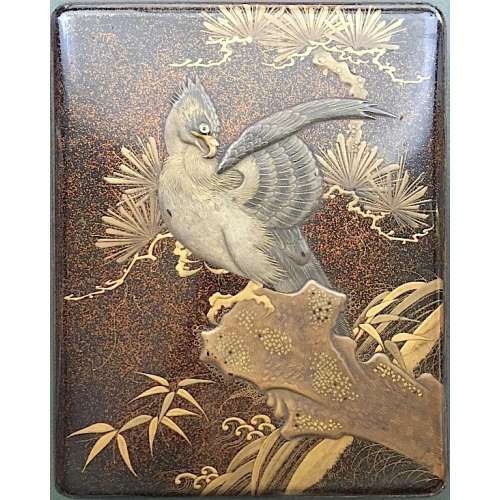 Japanese lacquer writing box (suzuribako) with an eagle sitting on a pine tree over the see waves. Rectangular box with rounded corners, slightly convex overlapping lid. Lacquer on wood with maki-e decoration in gold powder. The lid decorated inside with pine cones and needles over gold maki-e. Edo or Meiji period, 19th century.
Japanese lacquer writing box (suzuribako) with an eagle sitting on a pine tree over the see waves. Rectangular box with rounded corners, slightly convex overlapping lid. Lacquer on wood with maki-e decoration in gold powder. The lid decorated inside with pine cones and needles over gold maki-e. Edo or Meiji period, 19th century. -
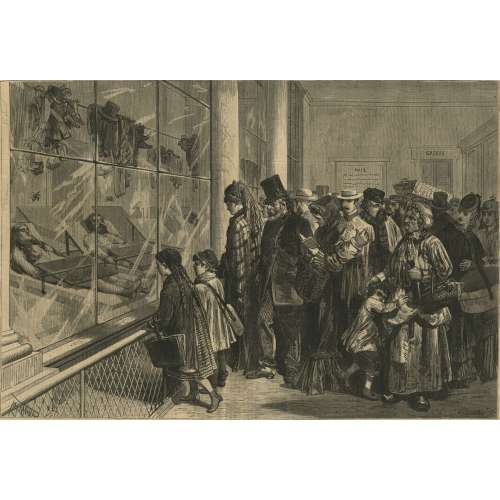
-
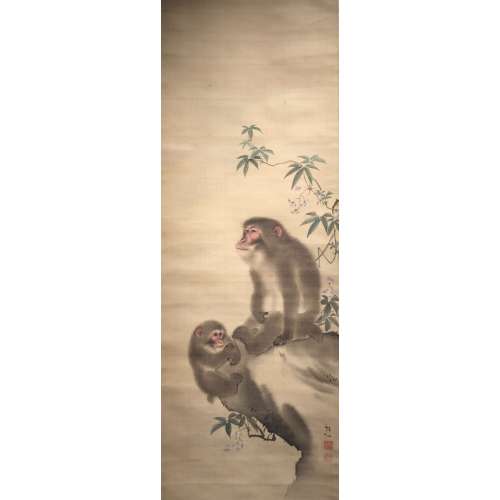 Mori Sosen (1747-1821). A Monkey Seated on a Rock with an Infant Monkey. Hanging scroll painting. Ink and colour on silk. Signed: Sosen. Sealed: Sosen. 108.3 x 38.3 cm. Provenance: According to the box inscriptions, the painting was in the possession of Itakura Katsunao, a daimyo lord in present-day Gunma, in 1808. In 1881, the painting was subsequently acquired by Negishi Shôrei (1833-1897) a master swordsman who established the Negishi school of shuriken ("The only specialist school to have survived is the Negishi-ryū, which was founded by Negishi Shorei in the mid-1800s".)
Mori Sosen (1747-1821). A Monkey Seated on a Rock with an Infant Monkey. Hanging scroll painting. Ink and colour on silk. Signed: Sosen. Sealed: Sosen. 108.3 x 38.3 cm. Provenance: According to the box inscriptions, the painting was in the possession of Itakura Katsunao, a daimyo lord in present-day Gunma, in 1808. In 1881, the painting was subsequently acquired by Negishi Shôrei (1833-1897) a master swordsman who established the Negishi school of shuriken ("The only specialist school to have survived is the Negishi-ryū, which was founded by Negishi Shorei in the mid-1800s".) -
 Iron tsuba of oval form with design of cherry blossoms in positive and negative silhouette openwork (ji-sukashi and in-sukashi). Details chiseled in kebori technique. Rounded rim. Copper sekigane. Higo school, Hayashi sub-school. Unsigned. Attributed to third generation Tōhachi (1723-1791). Edo period, 18th century (Hōreki / Meiwa era: 1751-1772). Height: 78.7 mm. Width: 72.2 mm. Rim thickness: 5.2 mm. Center thickness: 5.2 mm. Provenance: Sasano Masayuki Collection, № 289: "Hayashi. Third generation Tohachi (died in in the third year of Kansei, 1791 at the age of sixty-nine). Early 18th century (Hohreki / Meiwa era). "
Iron tsuba of oval form with design of cherry blossoms in positive and negative silhouette openwork (ji-sukashi and in-sukashi). Details chiseled in kebori technique. Rounded rim. Copper sekigane. Higo school, Hayashi sub-school. Unsigned. Attributed to third generation Tōhachi (1723-1791). Edo period, 18th century (Hōreki / Meiwa era: 1751-1772). Height: 78.7 mm. Width: 72.2 mm. Rim thickness: 5.2 mm. Center thickness: 5.2 mm. Provenance: Sasano Masayuki Collection, № 289: "Hayashi. Third generation Tohachi (died in in the third year of Kansei, 1791 at the age of sixty-nine). Early 18th century (Hohreki / Meiwa era). " -
 Mukade-zōgan tsuba with two types of wires. Iron, inlaid with brass and iron wire fastened to the surface with metal staples (mukade-zōgan); Brass inlay around the rim. Design is thought to resemble a centipede. "Centipede-like inlay (mukade zogan) of alternating iron and brass staples produce an appearance that was particularly favored by Takeda Shingen (1521-1573), one of the most powerful warlords of his time. The centipede is sacred to Bishamon (God of War) and especially propitious for a warrior. Shingen type, 16th century.” [The Peabody Museum collection of Japanese sword guards with selected pieces of sword furniture, by John D. Hamilton. Photographs by Mark Sexton. Salem, MA, 1975.] Height: 85.8 mm; Width 86.2 mm; Thickness at seppa-dai: 4.3 mm. Weight 177.6 g. Early Edo, 17th century. http://varshavskycollection.com/shingen-tsuba/
Mukade-zōgan tsuba with two types of wires. Iron, inlaid with brass and iron wire fastened to the surface with metal staples (mukade-zōgan); Brass inlay around the rim. Design is thought to resemble a centipede. "Centipede-like inlay (mukade zogan) of alternating iron and brass staples produce an appearance that was particularly favored by Takeda Shingen (1521-1573), one of the most powerful warlords of his time. The centipede is sacred to Bishamon (God of War) and especially propitious for a warrior. Shingen type, 16th century.” [The Peabody Museum collection of Japanese sword guards with selected pieces of sword furniture, by John D. Hamilton. Photographs by Mark Sexton. Salem, MA, 1975.] Height: 85.8 mm; Width 86.2 mm; Thickness at seppa-dai: 4.3 mm. Weight 177.6 g. Early Edo, 17th century. http://varshavskycollection.com/shingen-tsuba/ -
 Kitagawa Utamaro. Illustration from the book Ehon koi no Onamaki. Cited at Hayashi Yoshikazu's 20-volume set Edo makura-e shi shusei: Kitagawa Utamaro. Size: Chuban (25.5 x 18.5 cm), two book pages glued together.
Kitagawa Utamaro. Illustration from the book Ehon koi no Onamaki. Cited at Hayashi Yoshikazu's 20-volume set Edo makura-e shi shusei: Kitagawa Utamaro. Size: Chuban (25.5 x 18.5 cm), two book pages glued together. -
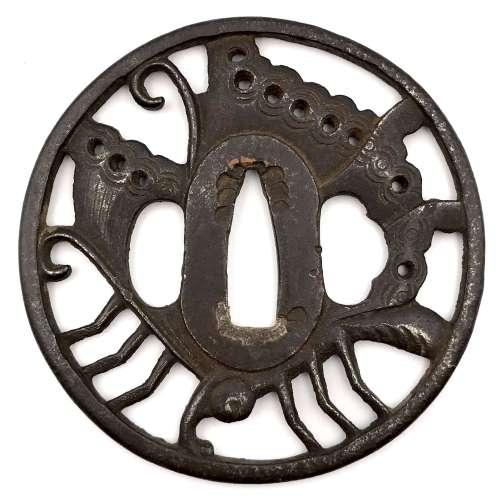 Iron tsuba of round form decorated with the design of a butterfly in openwork (sukashi) with details carved in kebori. Eyes inlaid in brass (one inlay is missing). Unsigned. Attributed to Bizen Shōami school, early Edo period (17th century). Dimensions: 80.4 x 80.6 x 4.4 mm References At Haynes Catalog #6, p. 18-19, Lot 30: "Famous Ikeda butterfly design" (Ikeda family of Inaba and Okayama, and at least 7 other families). Ca. 1700. Shōami of Kyoto, no doubt. Ht 8.2 cm, Th. 5 mm. ["Important tsuba, menuki, bokuto, woodblock prints, koshirae, sword pistol and kana mono". San Francisco, June 1-26, 1983. Catalog #6. Robert E. Haynes, Ltd.]Similar tsuba at Haynes Catalog #9, p.71, lot 143: the classic Shoami tsuba of the mon of the Ikeda family. This example, as most, seems to be made by the same hand as the others. See Haynes sale number 6, lot 30, for an identical example. The eye is brass. From an old French collection. Ht. 7.9 cm., Th. 5 mm.
Iron tsuba of round form decorated with the design of a butterfly in openwork (sukashi) with details carved in kebori. Eyes inlaid in brass (one inlay is missing). Unsigned. Attributed to Bizen Shōami school, early Edo period (17th century). Dimensions: 80.4 x 80.6 x 4.4 mm References At Haynes Catalog #6, p. 18-19, Lot 30: "Famous Ikeda butterfly design" (Ikeda family of Inaba and Okayama, and at least 7 other families). Ca. 1700. Shōami of Kyoto, no doubt. Ht 8.2 cm, Th. 5 mm. ["Important tsuba, menuki, bokuto, woodblock prints, koshirae, sword pistol and kana mono". San Francisco, June 1-26, 1983. Catalog #6. Robert E. Haynes, Ltd.]Similar tsuba at Haynes Catalog #9, p.71, lot 143: the classic Shoami tsuba of the mon of the Ikeda family. This example, as most, seems to be made by the same hand as the others. See Haynes sale number 6, lot 30, for an identical example. The eye is brass. From an old French collection. Ht. 7.9 cm., Th. 5 mm.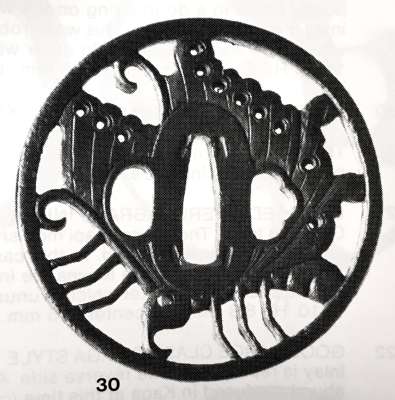
Haynes Catalog #6, lot 30.
Similar tsuba in the Randolph B. Caldwell Collection, 1994, page 24, №13: "A circular iron tsuba pierced in positive sukashi with a butterfly within an angular rim, details engraved. The eye inlaid in brass [in my specimen the inlay is missing on the omote side]. Unsigned. Bizen Shōami, Momoyama period. Dimensions: 8.0 x 8.2 x 0.5 cm. Similar example: Durand-Ruel, collection Ch. Gilloz, number 1302. [SV: that's possibly the 'old French collection' of Robert Haynes.]
Haynes Catalog #9, lot 143.
If we accept Haynes' theory regarding the genealogy and history of Bizen Shōami family, Momoyama period attribution would seem unlikely. I am leaning towards the early to mid 17th century.
Caldwell Collection, #13.
-
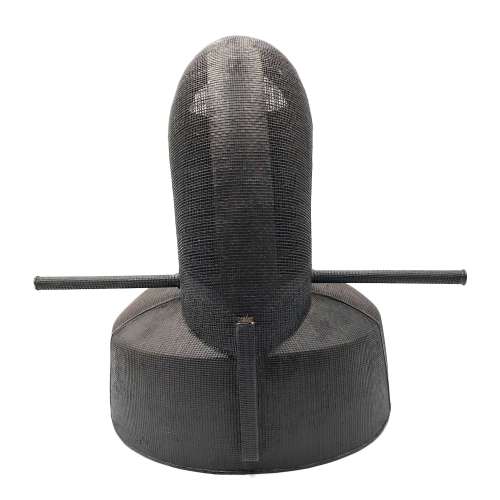 Kanmuri - a classic court cap, made of lacquered wood and paper. It is traditionally made by creating a skeleton, or harinuki, of paper on a wooden form. The outside of the hari-nuki is lacquered so as to keep its shape, and then the body of ra silk is layed on top. The entire thing is lacquered stiff.
Kanmuri - a classic court cap, made of lacquered wood and paper. It is traditionally made by creating a skeleton, or harinuki, of paper on a wooden form. The outside of the hari-nuki is lacquered so as to keep its shape, and then the body of ra silk is layed on top. The entire thing is lacquered stiff.Size: Height:20cm; Width: 21cm; Depth: 20cm.
Probably Taishō period (1912-1926), or later. Certain information is provided at http://www.sengokudaimyo.com/garb/garb.html In a wooden box without inscriptions. -
 The print lacks signature. It is attributed by some to Suzuki Harunobu and by the others to Isoda Koryūsai.
The print lacks signature. It is attributed by some to Suzuki Harunobu and by the others to Isoda Koryūsai.Attributed to Koryūsai: Pins #517/p.209, c. 1775 [AIC II: Clarence Buckingham Collection, 1925.2772], Ukiyo-e Taisei IV; Vignier & Inada, 1911; Ritsumeikan University Z0165-239.
Attributed to Harunobu: Pins #239/p.132.; BM 1906,1220,0.85;
-
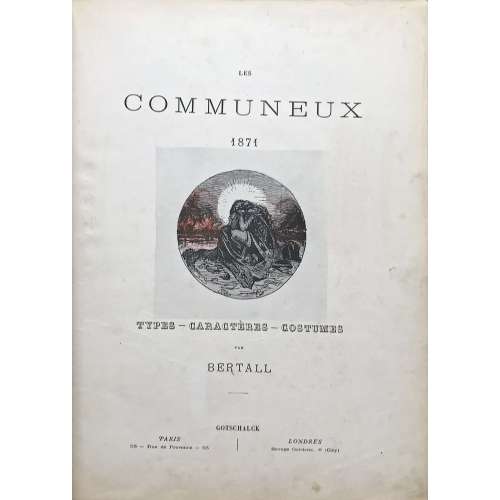 Folio (240 x 320 mm), hardbound in blue-aubergine cloth with gilt lettering and decoration. Album with Avant-Propos and 34 hand-colored lithographs by Bertall, numbered 1 through 34. Details in Russian: "Памяти парижской коммуны".
Folio (240 x 320 mm), hardbound in blue-aubergine cloth with gilt lettering and decoration. Album with Avant-Propos and 34 hand-colored lithographs by Bertall, numbered 1 through 34. Details in Russian: "Памяти парижской коммуны". -
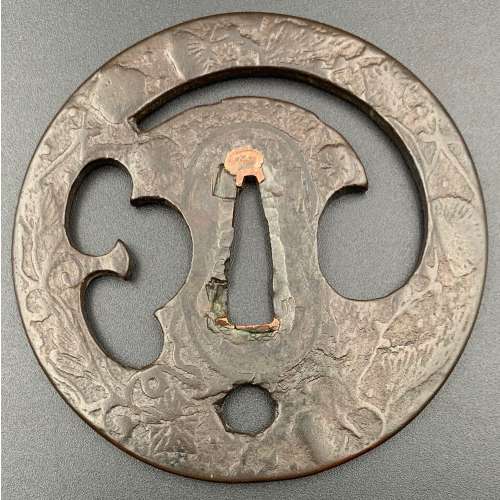
Yamagane (bronze) tsuba (kagami-shi, or mirror-maker) with the design of a star (round opening), tomoe (comma), and suhama in openwork. Surface cast and chiselled with the design of foliage, vines, blossoms, pine needles, and fruits on both sides.
The end of Early Muromachi period (1393-1453), circa 1450. Size: 83.7 x 84.1 x 3.6 (center), 4.1 (rim) mm; weight: 135.5 g. KANTEI-SHO (鑑定書) - APPRAISAL [translated by Markus Sesko]. No 463341 Tomoe-suhama-sukashi hana-karakusa no zu tsuba (巴洲浜透花唐草図鐔) ‒ Tsuba with stylized comma and bay inlet openwork and a flower and arabesque décor Unsigned: Kagami-shi (鏡師) Round shape, yamagane, hammer blow finish, cast, negative openwork design, round rim. According to the result of the shinsa committee of our society, we judge this work as authentic and rank it as Hozon Tōsōgu. July 1, 2011 [Foundation] Nihon Bijutsu Tōken Hozon Kyōkai, NBTHK (日本美術刀劍保存協會) -
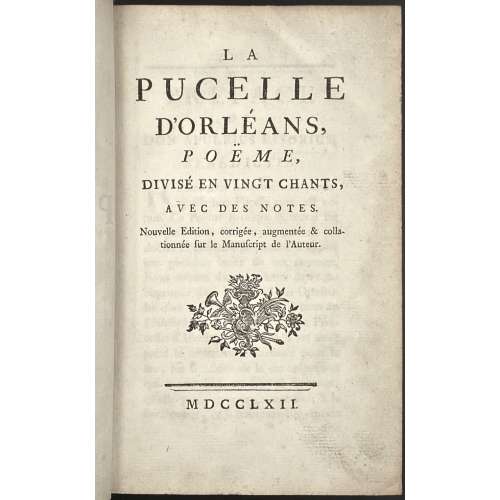 [François Marie Arouet de Voltaire]. La Pucelle d'Orléans, poëme, divisé en vingt chants, avec des notes. Nouvelle édition, corrigée, augmentée & collationnée sur le manuscript de l'auteur. – [Geneva: Gabriel Cramer], 1762.Illustrated book with 20 etchings and numerous woodcut vignettes.Illustrated by: Hubert-François Bourguignon, a.k.a. Gravelot (French, 1699–1773) Author: François Marie Arouet de Voltaire (French, 1694–1778) Printer: Gabriel Cramer (Swiss, 1723–1793)Pagination: [2 blanks, "Ex libris JCP" to recto] [2 - h.t., blank] [2 - t.p., blank], [i] ii-viii, [1] 2-358 [2 blanks]; 20 engraved plates, unsigned, one before every chant, by Gravelot (Hubert-François Bourguignon).Year of Publication: 1762Place of Publication: Geneva, SwitzerlandSize: 8vo, 19.8 x 12.6 x 3.7 cm.Binding: Full mottled calf, restored, flat spine, decorated in gilt, red labels with gilt lettering "Oeuvres de Voltaire; La Pucelle, tom XXII"; marbled endpapers and all margins.CATALOGUE RAISONNÉ: Cohen-de Ricci 1029.Mentions: MFA: ACCESSION NUMBER 25.701.Another copy in this collection: LIB-2580.2020.
[François Marie Arouet de Voltaire]. La Pucelle d'Orléans, poëme, divisé en vingt chants, avec des notes. Nouvelle édition, corrigée, augmentée & collationnée sur le manuscript de l'auteur. – [Geneva: Gabriel Cramer], 1762.Illustrated book with 20 etchings and numerous woodcut vignettes.Illustrated by: Hubert-François Bourguignon, a.k.a. Gravelot (French, 1699–1773) Author: François Marie Arouet de Voltaire (French, 1694–1778) Printer: Gabriel Cramer (Swiss, 1723–1793)Pagination: [2 blanks, "Ex libris JCP" to recto] [2 - h.t., blank] [2 - t.p., blank], [i] ii-viii, [1] 2-358 [2 blanks]; 20 engraved plates, unsigned, one before every chant, by Gravelot (Hubert-François Bourguignon).Year of Publication: 1762Place of Publication: Geneva, SwitzerlandSize: 8vo, 19.8 x 12.6 x 3.7 cm.Binding: Full mottled calf, restored, flat spine, decorated in gilt, red labels with gilt lettering "Oeuvres de Voltaire; La Pucelle, tom XXII"; marbled endpapers and all margins.CATALOGUE RAISONNÉ: Cohen-de Ricci 1029.Mentions: MFA: ACCESSION NUMBER 25.701.Another copy in this collection: LIB-2580.2020.



